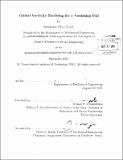| dc.contributor.advisor | Michael S. Triantafyllou. | en_US |
| dc.contributor.author | Steele, Stephanie Chin | en_US |
| dc.contributor.other | Massachusetts Institute of Technology. Dept. of Mechanical Engineering. | en_US |
| dc.date.accessioned | 2013-03-28T18:13:15Z | |
| dc.date.available | 2013-03-28T18:13:15Z | |
| dc.date.copyright | 2012 | en_US |
| dc.date.issued | 2012 | en_US |
| dc.identifier.uri | http://hdl.handle.net/1721.1/78192 | |
| dc.description | Thesis (S.M. in Ocean Engineering)--Massachusetts Institute of Technology, Dept. of Mechanical Engineering, 2012. | en_US |
| dc.description | Cataloged from PDF version of thesis. | en_US |
| dc.description | Includes bibliographical references (p. 59-60). | en_US |
| dc.description.abstract | We explore several aspects of the phenomenon we call global vorticity shedding. Global vorticity shedding occurs when an object in viscous fluid suddenly vanishes, shedding the entire boundary layer vorticity into the wake at once. In our experiments we approximate the disappearance of a towed foil by rapidly retracting the foil in the span-wise direction. Global vorticity shedding is in distinct contrast with conventional shedding, in which vorticity is shed from a body from only a few separation points into the fluid. In this work, we show that for a square-tipped vanishing foil at an angle of attack, the globally shed boundary layer vorticity forms into primary vortices, which evolve and eventually amalgamate with secondary vortices to leave two lasting vortices in the wake. The secondary vortices are a result of three-dimensionality in the flow. For a streamlined-end foil, we achieve a simpler and less three-dimensional wake with no secondary vortices, arid only one lasting vortex dominating the wake. However, due to the initial vorticity distribution near the streamlined end of the foil, the initial circulation is reduced. We also show that the lasting vortices are capable of producing reasonably large forces on a body through simple potential flow estimations, aid that vortex formation times are small, with vortices fully formed nearly instantaneously in the flow. These features are promising for a force transducer using global vorticity shedding to impart large and fast maneuvering forces on an underwater vehicle. | en_US |
| dc.description.statementofresponsibility | by Stephanie Chin Steele. | en_US |
| dc.format.extent | 60 p. | en_US |
| dc.language.iso | eng | en_US |
| dc.publisher | Massachusetts Institute of Technology | en_US |
| dc.rights | M.I.T. theses are protected by
copyright. They may be viewed from this source for any purpose, but
reproduction or distribution in any format is prohibited without written
permission. See provided URL for inquiries about permission. | en_US |
| dc.rights.uri | http://dspace.mit.edu/handle/1721.1/7582 | en_US |
| dc.subject | Mechanical Engineering. | en_US |
| dc.title | Global vorticity shedding for a vanishing foil | en_US |
| dc.type | Thesis | en_US |
| dc.description.degree | S.M.in Ocean Engineering | en_US |
| dc.contributor.department | Massachusetts Institute of Technology. Department of Mechanical Engineering | |
| dc.identifier.oclc | 830376795 | en_US |
